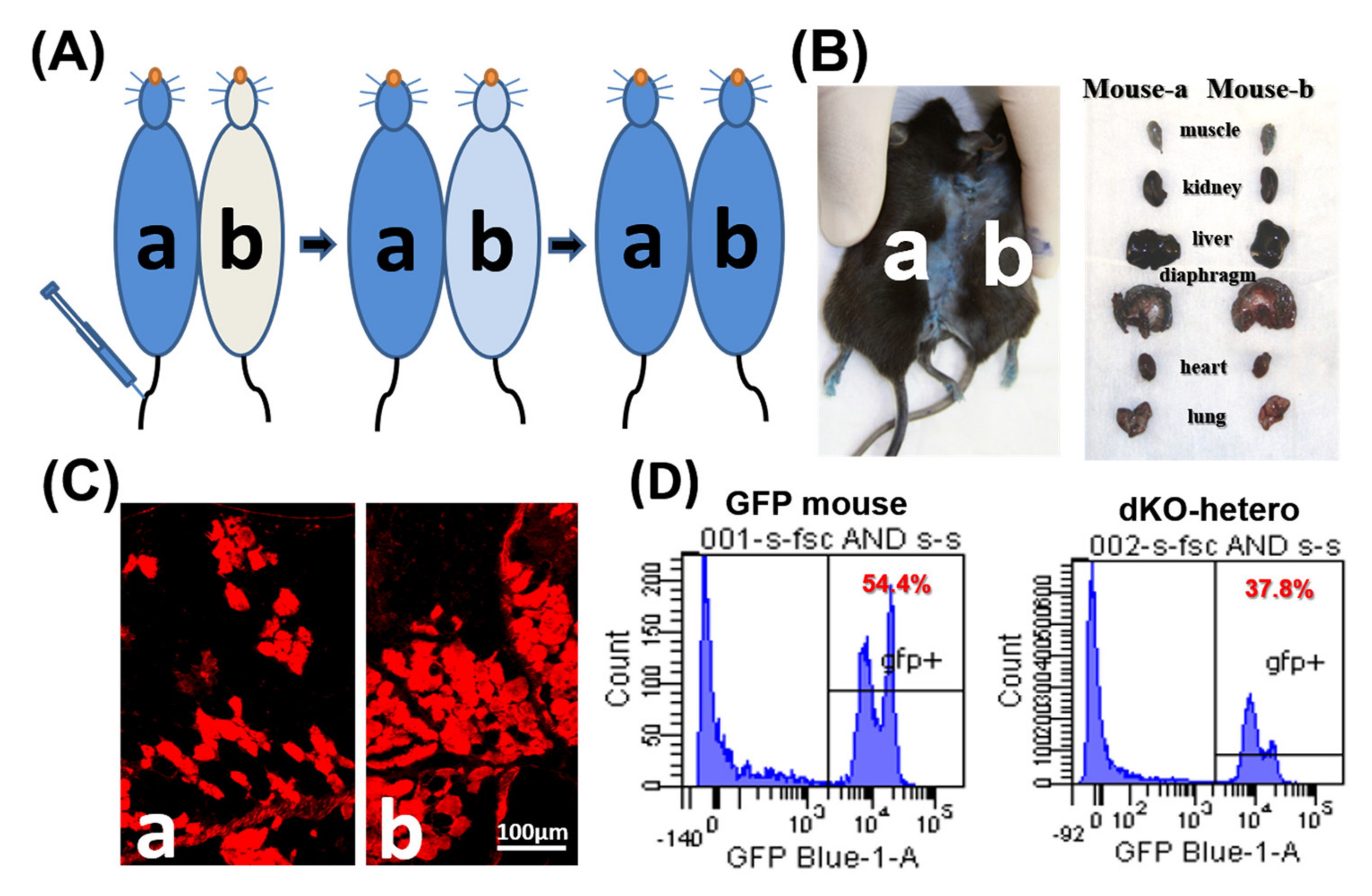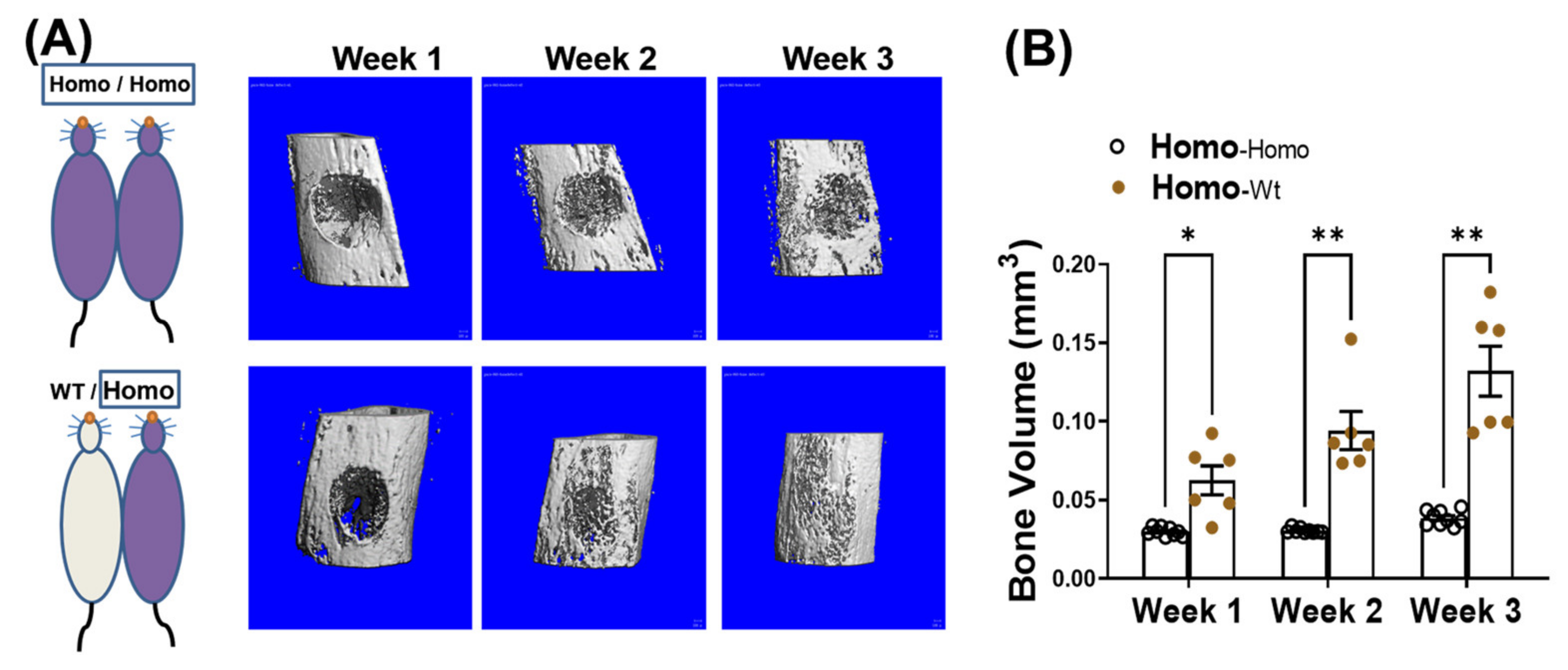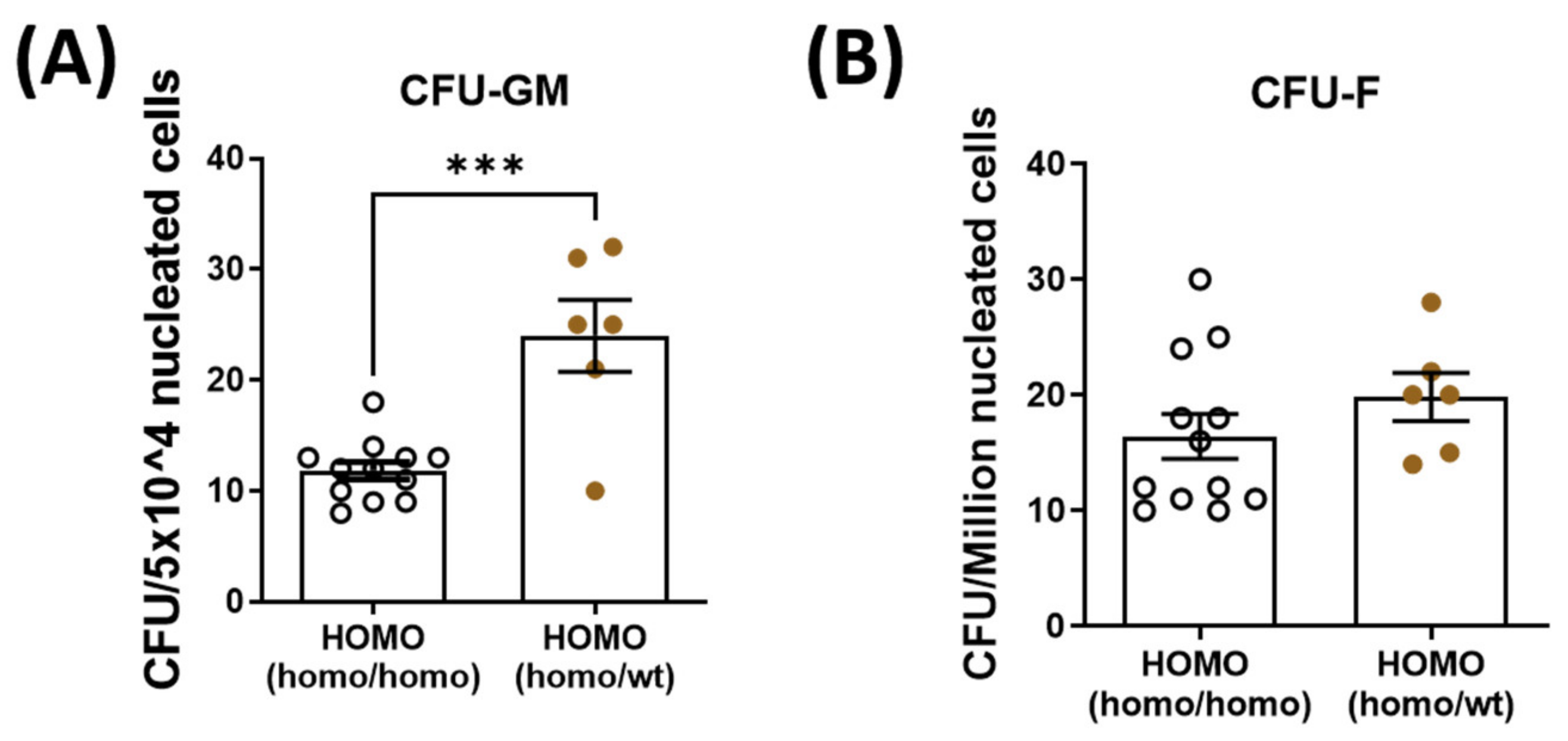Improved Bone Quality and Bone Healing of Dystrophic Mice by Parabiosis
Abstract
:1. Introduction
2. Results
2.1. Cross-Circulation in Parabiotic Pairs
2.2. Increased Bone Mass and Improved Bone Micro-Structure in Old dKO-Hetero Mice after Pairing with Young Mdx Mice
2.3. Improved Bone Healing of dKO-Homo Mice after Paring with WT Mice
2.4. Quantification of Bone Marrow Mesenchymal Stem Cells (CFU-F) and Hematopoietic Stem Cells (CFU-GM) Isolated from the Bone Marrow
3. Discussion
4. Materials and Methods
4.1. Animals
4.2. Parabiosis Procedure and Chimera Generation
4.3. Tibia Bone Defect Healing
4.4. Micro-CT Bone Histomorphometric Assessment
4.5. Colony Forming Unit (CFU) Assay
4.6. Statistical Analysis
5. Conclusions
Author Contributions
Funding
Institutional Review Board Statement
Informed Consent Statement
Data Availability Statement
Acknowledgments
Conflicts of Interest
References
- Hoffman, E.P.; Monaco, A.P.; Feener, C.C.; Kunkel, L.M. Conservation of the Duchenne muscular dystrophy gene in mice and humans. Science 1987, 238, 347–350. [Google Scholar] [CrossRef] [PubMed]
- Hoffman, E.P.; Brown, R.H., Jr.; Kunkel, L.M. Dystrophin: The protein product of the Duchenne muscular dystrophy locus. Cell 1987, 51, 919–928. [Google Scholar] [CrossRef]
- Larson, C.M.; Henderson, R.C. Bone mineral density and fractures in boys with Duchenne muscular dystrophy. J. Pediatric Orthop. 2000, 20, 71–74. [Google Scholar] [CrossRef]
- McDonald, D.G.; Kinali, M.; Gallagher, A.C.; Mercuri, E.; Muntoni, F.; Roper, H.; Jardine, P.; Jones, D.H.; Pike, M.G. Fracture prevalence in Duchenne muscular dystrophy. Dev. Med. Child Neurol. 2002, 44, 695–698. [Google Scholar] [CrossRef]
- Vestergaard, P.; Glerup, H.; Steffensen, B.F.; Rejnmark, L.; Rahbek, J.; Moseklide, L. Fracture risk in patients with muscular dystrophy and spinal muscular atrophy. J. Rehabil. Med. Off. J. UEMS Eur. Board Phys. Rehabil. Med. 2001, 33, 150–155. [Google Scholar] [CrossRef]
- Bianchi, M.L.; Mazzanti, A.; Galbiati, E.; Saraifoger, S.; Dubini, A.; Cornelio, F.; Morandi, L. Bone mineral density and bone metabolism in Duchenne muscular dystrophy. Osteoporos. Int. A J. Establ. Result Coop. Eur. Found. Osteoporos. Natl. Osteoporos. Found. USA 2003, 14, 761–767. [Google Scholar] [CrossRef]
- Bulfield, G.; Siller, W.G.; Wight, P.A.; Moore, K.J. X chromosome-linked muscular dystrophy (mdx) in the mouse. Proc. Natl. Acad. Sci. USA 1984, 81, 1189–1192. [Google Scholar] [CrossRef] [Green Version]
- Sicinski, P.; Geng, Y.; Ryder-Cook, A.S.; Barnard, E.A.; Darlison, M.G.; Barnard, P.J. The molecular basis of muscular dystrophy in the mdx mouse: A point mutation. Science 1989, 244, 1578–1580. [Google Scholar] [CrossRef]
- Deconinck, A.E.; Rafael, J.A.; Skinner, J.A.; Brown, S.C.; Potter, A.C.; Metzinger, L.; Watt, D.J.; Dickson, J.G.; Tinsley, J.M.; Davies, K.E. Utrophin-dystrophin-deficient mice as a model for Duchenne muscular dystrophy. Cell 1997, 90, 717–727. [Google Scholar] [CrossRef] [Green Version]
- Grady, R.M.; Teng, H.; Nichol, M.C.; Cunningham, J.C.; Wilkinson, R.S.; Sanes, J.R. Skeletal and cardiac myopathies in mice lacking utrophin and dystrophin: A model for Duchenne muscular dystrophy. Cell 1997, 90, 729–738. [Google Scholar] [CrossRef] [Green Version]
- Salvador, D.R.; Rey, N.R.; Ramos, G.C.; Punzalan, F.E. Continuous infusion versus bolus injection of loop diuretics in congestive heart failure. Cochrane Database Syst. Rev. 2005, CD003178. [Google Scholar] [CrossRef]
- Nigro, G.; Comi, L.I.; Politano, L.; Bain, R.J. The incidence and evolution of cardiomyopathy in Duchenne muscular dystrophy. Int. J. Cardiol. 1990, 26, 271–277. [Google Scholar] [CrossRef]
- Sanyal, S.K.; Johnson, W.W.; Thapar, M.K.; Pitner, S.E. An ultrastructural basis for electrocardiographic alterations associated with Duchenne′s progressive muscular dystrophy. Circulation 1978, 57, 1122–1129. [Google Scholar] [CrossRef] [Green Version]
- Townsend, D.; Blankinship, M.J.; Allen, J.M.; Gregorevic, P.; Chamberlain, J.S.; Metzger, J.M. Systemic Administration of Micro-dystrophin Restores Cardiac Geometry and Prevents Dobutamine-induced Cardiac Pump Failure. Mol. Ther. 2007, 15, 1086–1092. [Google Scholar] [CrossRef]
- Isaac, C.; Wright, A.; Usas, A.; Li, H.; Tang, Y.; Mu, X.; Greco, N.; Dong, Q.; Vo, N.; Kang, J.; et al. Dystrophin and utrophin “double knockout” dystrophic mice exhibit a spectrum of degenerative musculoskeletal abnormalities. J. Orthop. Res. 2013, 31, 343–349. [Google Scholar] [CrossRef] [Green Version]
- Mu, X.; Usas, A.; Tang, Y.; Lu, A.; Wang, B.; Weiss, K.; Huard, J. RhoA mediates defective stem cell function and heterotopic ossification in dystrophic muscle of mice. FASEB J. 2013, 27, 3619–3631. [Google Scholar] [CrossRef] [Green Version]
- Gao, X.; Tang, Y.; Amra, S.; Sun, X.; Cui, Y.; Cheng, H.; Wang, B.; Huard, J. Systemic investigation of bone and muscle abnormalities in dystrophin/utrophin double knockout mice during postnatal development and the mechanisms. Hum. Mol. Genet. 2019, 28, 1738–1751. [Google Scholar] [CrossRef]
- Lukic, I.K.; Kovacic, N.; Katavic, V.; Grcevic, D.; Ivcevic, S.; Marusic, A. Shared circulation in parabiosis leads to the transfer of bone phenotype from gld to the wild-type mice. Cell Immunol. 2005, 233, 133–139. [Google Scholar] [CrossRef]
- Buring, K. On the origin of cells in heterotopic bone formation. Clin. Orthop. Relat. Res. 1975, 110, 293–301. [Google Scholar] [CrossRef] [PubMed]
- Boban, I.; Barisic-Dujmovic, T.; Clark, S.H. Parabiosis model does not show presence of circulating osteoprogenitor cells. Genesis 2010, 48, 171–182. [Google Scholar] [CrossRef]
- Conboy, I.M.; Conboy, M.J.; Wagers, A.J.; Girma, E.R.; Weissman, I.L.; Rando, T.A. Rejuvenation of aged progenitor cells by exposure to a young systemic environment. Nature 2005, 433, 760–764. [Google Scholar] [CrossRef]
- Brack, A.S.; Conboy, M.J.; Roy, S.; Lee, M.; Kuo, C.J.; Keller, C.; Rando, T.A. Increased Wnt signaling during aging alters muscle stem cell fate and increases fibrosis. Science 2007, 317, 807–810. [Google Scholar] [CrossRef] [PubMed]
- Gibney, B.C.; Chamoto, K.; Lee, G.S.; Simpson, D.C.; Miele, L.F.; Tsuda, A.; Konerding, M.A.; Wagers, A.; Mentzer, S.J. Cross-circulation and cell distribution kinetics in parabiotic mice. J. Cell Physiol. 2012, 227, 821–828. [Google Scholar] [CrossRef] [PubMed] [Green Version]
- Finerty, J.C.; Panos, T.C. Parabiosis intoxication. Proc. Soc. Exp. Biol Med. 1951, 76, 833–835. [Google Scholar] [CrossRef] [Green Version]
- Hall, C.E.; Hall, O.; Nevis, A.H. Prolongation of survival by parabiosis in strain 129 dystrophic mice. Am. J. Physiol 1959, 196, 110–112. [Google Scholar] [CrossRef] [Green Version]
- Pope, R.S.; Murphy, E.D. Survival of strain 129 dystrophic mice in parabiosis. Am. J. Physiol. 1960, 199, 1097–1100. [Google Scholar] [CrossRef] [Green Version]
- Pope, R.S.; Murphy, E.D.; West, W.T. Decreased Longevity of Strain 129 Dystrophic Mice Parabiosed at Weaning. Am. J. Physiol. 1964, 207, 449–451. [Google Scholar] [CrossRef]
- Pope, R.S.; Murphy, E.D.; West, W.T. Histopathology of Dystrophic and Normal Mice after Timed Periods of Parabiosis. Anat Rec. 1965, 151, 151–157. [Google Scholar] [CrossRef]
- Rufo, A.; Del Fattore, A.; Capulli, M.; Carvello, F.; De Pasquale, L.; Ferrari, S.; Pierroz, D.; Morandi, L.; De Simone, M.; Rucci, N.; et al. Mechanisms inducing low bone density in Duchenne muscular dystrophy in mice and humans. J. Bone Miner. Res. 2011, 26, 1891–1903. [Google Scholar] [CrossRef] [Green Version]
- Dufresne, S.S.; Boulanger-Piette, A.; Bosse, S.; Argaw, A.; Hamoudi, D.; Marcadet, L.; Gamu, D.; Fajardo, V.A.; Yagita, H.; Penninger, J.M.; et al. Genetic deletion of muscle RANK or selective inhibition of RANKL is not as effective as full-length OPG-fc in mitigating muscular dystrophy. Acta Neuropathol. Commun. 2018, 6, 31. [Google Scholar] [CrossRef] [Green Version]
- Hamoudi, D.; Marcadet, L.; Piette Boulanger, A.; Yagita, H.; Bouredji, Z.; Argaw, A.; Frenette, J. An anti-RANKL treatment reduces muscle inflammation and dysfunction and strengthens bone in dystrophic mice. Hum. Mol. Genet. 2019, 28, 3101–3112. [Google Scholar] [CrossRef] [PubMed]
- Bonnet, N.; Bourgoin, L.; Biver, E.; Douni, E.; Ferrari, S. RANKL inhibition improves muscle strength and insulin sensitivity and restores bone mass. J. Clin. Investig. 2019, 129, 3214–3223. [Google Scholar] [CrossRef] [PubMed]
- Zhou, S.; Qian, B.; Wang, L.; Zhang, C.; Hogan, M.V.; Li, H. Altered bone-regulating myokine expression in skeletal muscle Of Duchenne muscular dystrophy mouse models. Muscle Nerve 2018, 58, 573–582. [Google Scholar] [CrossRef] [PubMed]
- Li, H.; Sun, H.; Qian, B.; Feng, W.; Carney, D.; Miller, J.; Hogan, M.V.; Wang, L. Increased Expression of FGF-21 Negatively Affects Bone Homeostasis in Dystrophin/Utrophin Double Knockout Mice. J. Bone Miner. Res. 2020, 35, 738–752. [Google Scholar] [CrossRef]
- Kuznetsov, S.A.; Mankani, M.H.; Gronthos, S.; Satomura, K.; Bianco, P.; Robey, P.G. Circulating skeletal stem cells. J. Cell Biol. 2001, 153, 1133–1140. [Google Scholar] [CrossRef] [Green Version]
- Otsuru, S.; Tamai, K.; Yamazaki, T.; Yoshikawa, H.; Kaneda, Y. Bone marrow-derived osteoblast progenitor cells in circulating blood contribute to ectopic bone formation in mice. Biochem. Biophys Res. Commun. 2007, 354, 453–458. [Google Scholar] [CrossRef]
- Kumagai, K.; Vasanji, A.; Drazba, J.A.; Butler, R.S.; Muschler, G.F. Circulating cells with osteogenic potential are physiologically mobilized into the fracture healing site in the parabiotic mice model. J. Orthop. Res. 2008, 26, 165–175. [Google Scholar] [CrossRef]
- Mosqueira, M.; Baby, S.M.; Lahiri, S.; Khurana, T.S. Ventilatory chemosensory drive is blunted in the mdx mouse model of Duchenne Muscular Dystrophy (DMD). PLoS ONE 2013, 8, e69567. [Google Scholar] [CrossRef] [Green Version]
- Deconinck, A.E.; Potter, A.C.; Tinsley, J.M.; Wood, S.J.; Vater, R.; Young, C.; Metzinger, L.; Vincent, A.; Slater, C.R.; Davies, K.E. Postsynaptic abnormalities at the neuromuscular junctions of utrophin-deficient mice. J. Cell Biol. 1997, 136, 883–894. [Google Scholar] [CrossRef] [Green Version]
- Conboy, M.J.; Conboy, I.M.; Rando, T.A. Heterochronic parabiosis: Historical perspective and methodological considerations for studies of aging and longevity. Aging Cell 2013, 12, 525–530. [Google Scholar] [CrossRef] [Green Version]
- Matsuda, R.; Nishikawa, A.; Tanaka, H. Visualization of dystrophic muscle fibers in mdx mouse by vital staining with Evans blue: Evidence of apoptosis in dystrophin-deficient muscle. J. Biochem. 1995, 118, 959–964. [Google Scholar] [CrossRef]
- Li, H.; Hamza, T.; Tidwell, J.E.; Clovis, N.; Li, B. Unique antimicrobial effects of platelet-rich plasma and its efficacy as a prophylaxis to prevent implant-associated spinal infection. Adv. Healthc Mater. 2013, 2, 1277–1284. [Google Scholar] [CrossRef] [Green Version]




Publisher’s Note: MDPI stays neutral with regard to jurisdictional claims in published maps and institutional affiliations. |
© 2021 by the authors. Licensee MDPI, Basel, Switzerland. This article is an open access article distributed under the terms and conditions of the Creative Commons Attribution (CC BY) license (https://creativecommons.org/licenses/by/4.0/).
Share and Cite
Li, H.; Lu, A.; Gao, X.; Tang, Y.; Ravuri, S.; Wang, B.; Huard, J. Improved Bone Quality and Bone Healing of Dystrophic Mice by Parabiosis. Metabolites 2021, 11, 247. https://doi.org/10.3390/metabo11040247
Li H, Lu A, Gao X, Tang Y, Ravuri S, Wang B, Huard J. Improved Bone Quality and Bone Healing of Dystrophic Mice by Parabiosis. Metabolites. 2021; 11(4):247. https://doi.org/10.3390/metabo11040247
Chicago/Turabian StyleLi, Hongshuai, Aiping Lu, Xueqin Gao, Ying Tang, Sudheer Ravuri, Bing Wang, and Johnny Huard. 2021. "Improved Bone Quality and Bone Healing of Dystrophic Mice by Parabiosis" Metabolites 11, no. 4: 247. https://doi.org/10.3390/metabo11040247
APA StyleLi, H., Lu, A., Gao, X., Tang, Y., Ravuri, S., Wang, B., & Huard, J. (2021). Improved Bone Quality and Bone Healing of Dystrophic Mice by Parabiosis. Metabolites, 11(4), 247. https://doi.org/10.3390/metabo11040247





